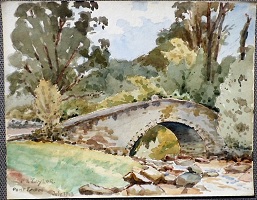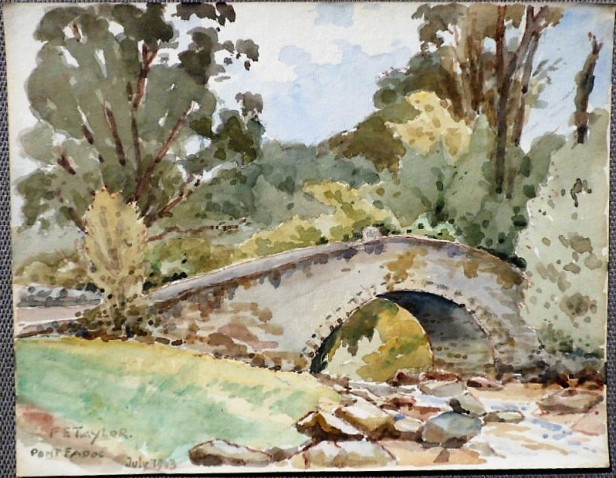ABOUT THE ARTIST:
I know little about F*E* TAYLOR except that he is recorded as exhibiting at The Royal Academy in 1908 when his address was 10 Cobham Rd., Kingston Hill, Surrey.
I acquired a large collection of his watercolours dating from 1935 to 1946 during which time he produced paintings of The Italian Alps, Switzerland, North Wales, Berkshire, Buckinghamshire, Cornwall, Devon, Oxfordshire, Surrey and Worcestershire. Judging only by the number of paintings from the different areas, I conclude that he lived in Buckinghamshire and possibly near High Wickham.
IMAGE:



TITLE: Pont Fadog
PRICE: £20.00 Ref: 20170531049 BGO – SOLD
If you are sure you would like to buy this painting please click on the appropriate
At the PayPal check out, the price you will be asked to pay will include packing and shipping. Tracked courier delivery with appropriate insurance cover will be included. I have estimated the cost but any overpayment will be refunded to your PayPal account.
SPECIFICATION:
MEDIUM: Watercolour on paper
APPROXIMATE SIZE:
Painting: 225 mm x 275 mm 8 3/4” x 10 3/4”
Frame / Mount: Unmounted – Unframed
ANNOTATIONS:
Signed F E Taylor lower left
Inscribed Lower left – Pont Fadoc July 1943
THE STORY:
Pontfadog is close to Chirk in North East Wales. Its main claim to fame was the Oak near the bridge. It looks as if it is the tree on the left beyond the bridge in the painting.
So, why was this tree famous? Well, in 1165, it was reputed to be the oldest tree in Great Britain. It is for that reason that King Henry II spared it when his men were felling all the trees alongside the road in the Ceiriog Valley.
Why did the King want to fell the trees? It was a common practice to clear the sides of all roads used by government people. The reason was that it deprived marauding gangs from setting up ambushes.
It must have been enormous. In 1881 its girth was measured at 53 feet. It was said more recently that it was the largest oak tree in the world. But, in 2913, strong winds blew it down. Its centre was hollow as is often the case with very old oak trees which have been hollowed out by fungal infestations.
The article in the Guardian is interesting:
https://www.theguardian.com/environment/2013/apr/28/pontfadog-oak-revered-loved-mourned
It was a Sessile Oak which is considered the national tree of Wales.
The Oak trees of Wales have had a rough time of it through history. It seems that they have been felled in large numbers at different times for various reasons. In this case it was King Henry II. Later on in the late 18th Century it was Admiral Rodney who pretty much cleared Montgomeryshire of oak which was floated down the River Severn to Bristol to be used as ‘The Hearts of Oak’ to build the ‘Wooden Walls of England’.
It is interesting that so many people have forgotten the vital the contribution of Wales to building of the Royal Navy’s ships and, much earlier, at Crécy and Agincourt during the Hundred Years War when most of the archers were provided by Wales.
It is difficult to conceive the contribution of the longbow to warfare in the 14th and 15th Centuries. Longbows were made from Yew wood which is naturally laminated and retains its ability to return to its original state when released from pressure. The draw on a longbow was around 80 pounds. Inspite of the better food we eat these days, few, even strong men, can draw a longbow with ease. Longbow men in history fired 7 or more aimed arrows per minute. It was as devastating as the machine gun in later conflicts.
The range of a longbow was greater than the 300 metre battle range of a modern assault rifle.
There were numerous different arrow-heads. I think it was called a bodkin head which was used as an armour piercing arrow to pierce mediaeval armour.
In 1403, the loss of life per hour of battle at the Battle of Shrewsbury was greater than during any other battle until the Battle of the Somme in 1916.
On the same theme, the first import from Finland to Great Britain was Yew staves for making longbows.
PLEASE NOTE:
I do my best to find out as much as I can about my paintings and the artists who made them.
I also try to give you a little extra information about the subjects shown in my paintings.
I believe that the information above is accurate.
Let me apologise for any errors or typos you may find, they are wholly my own.
Please tell me if my memory has failed me as it sometimes does.
Any images posted with this description form part of the description.
Please ensure you look very carefully at all images and details to make sure that you really really want the picture before you buy or bid.
Thank you for looking at my painting.
Keep safe and well,
Best wishes,
Dai.
email address: DaiOakley@hotmail.com
E&OE

